ShowNET as laser mainboard - features and opportunities
ShowNet is a multi-feature mainboard for laser systems. It can act as DAC / interface, but also makes laser systems intelligent lighting devices.
Directly jump to the very features:
- Use ShowNET for ArtNET laser control
- Use ShowNET for DMX laser control
- Use ShowNET for Stand-Alone laser operation
- Use ShowNET for Sound-to-Light / music triggered laser operation
- Use ShowNET as DAC / laser interface for direct software laser control via Showcontroller
- Use ShowNET as DAC / laser interface for direct software laser control via Showeditor
- Use ShowNET for ILDA Streaming
- Use ShowNET for Master-Slave laser operation
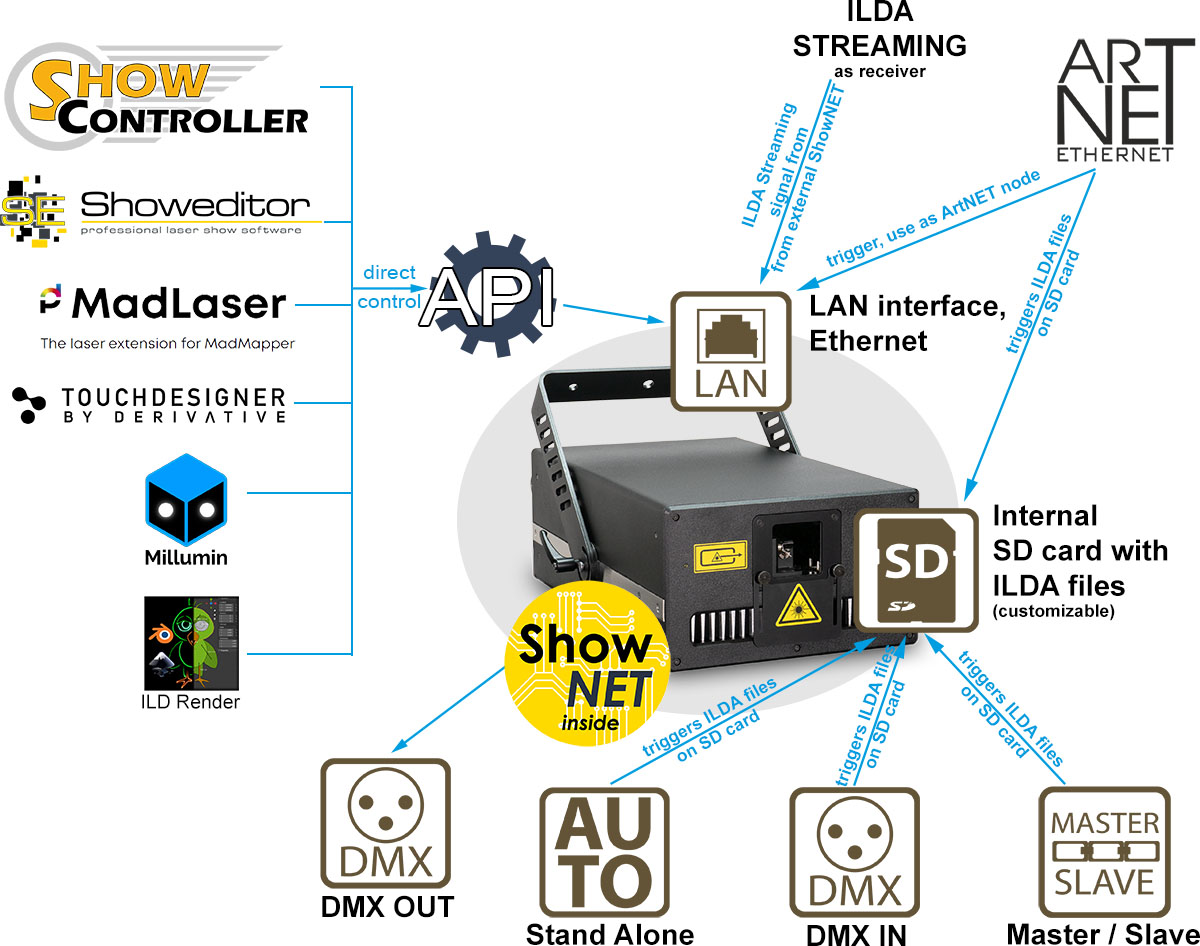
Control options of the internal ShowNET board:
- ArtNET control
- Sound-to-Light operation (only available with integrated boards, if microphone board is connected)
- Demo-Mode - with automatic animation of the patterns on teh SD-card
- Automatic- / Stand-Alone-Mode, manual file triggering is possible
- ILDA Streaming over LAN (ILDA Transceiver feature)
- Compatible to various laser control software, like Showeditor or Showcontroller
Hardware features of the internal ShowNET board:
- X/Y scanner outputs with 12 bit resolution (4096 different positions on each axis)
- Color outputs with 8 bit resolution (256 different intensity values per color channel): red, green, blue, intensity linked to green
- MicroSD card for ILDA file playback (ILDA format code 4/5 RGB)
- DMX512 input and output (non-isolated)
- 100 Mbit Ethernet port
- Flexible IP address setting: static address, DHCP or AutoIP
- Maximum scan speed ~100.000 points per second
- Up to 16 devices can be used in parallel for multiprojector laser shows
- Built-in ArtNet-to-DMX converter
The technical features of the ShowNET interface also significantly depend on the firmware: The latest firmware releases bring many new features to the ShowNET interfaces, like different DMX profiles (depending on the type of use) with new features like safety zones, color balancing or RGB color picker support over DMX/ArtNET.
1. Use ShowNET for ArtNET laser control
ShowNET can easily be used with ArtNET for convenient laser control via conventional lighting desks or lighting software.
Custom ILDA files can be stored to the ShowNET's internal SD card and can then be triggered via ArtNET. Even though the ShowNET already comes with a preset of Frames and animations, it is possible to completely customize all these contents. This is comparable to using "Gobos", like in conventional lighting, but these "Gobos" in lasers can not only be static, but be animated, colorful and easily customizable.
ShowNET comes with a free software that allows for creation of custom content, which then can be loaded to the ShowNET's SD card.
ShowNET has an integrated ArtNET node, so lasers with integrated ShowNET as mainboard can simply be connected via LAN cable. Wiring and handling is similar to the use of ArtNET with conventional intelligent lighting, like moving lights.
As standard, ShowNET is set to DMX-operation. To switch it to ArtNET mode, use the ShowNET Admin Tool and change the settings (see manual for instructions).
You can use any lighting desk for ArtNET controlling the ShowNET, as long as it supports ArtNET - it can be a Grand MA, Avolites desk, any other lighting desk or control software.
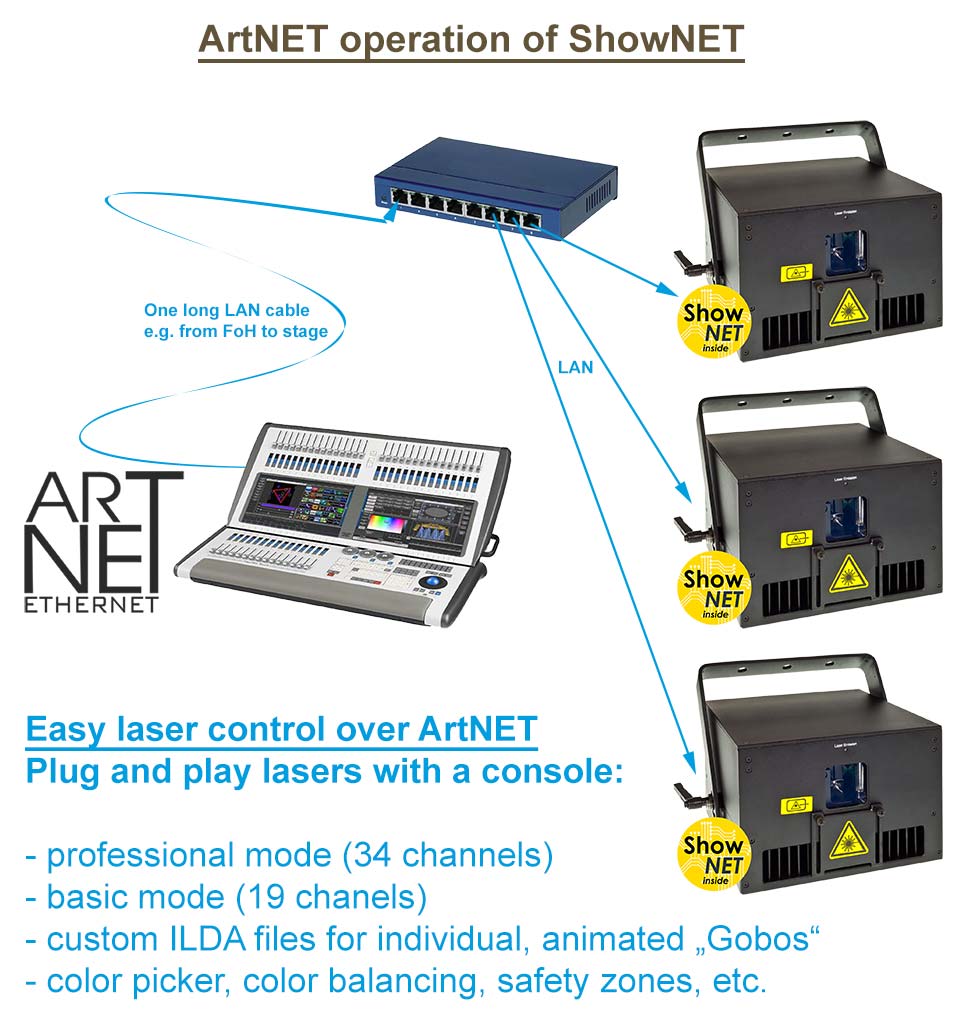
2. Use ShowNET for DMX laser control
ShowNET can easily be used with DMX512 for convenient laser control via conventional lighting desks or lighting software.
Custom ILDA files can be stored to the ShowNET's internal SD card and can then be triggered via DMX. Even though the ShowNET already comes with a preset of frames and animations, it is possible to completely customize all these contents. This is comparable to using "Gobos", like in conventional lighting, but these "Gobos" in lasers can not only be static, but be animated, colorful and easily customizable.
ShowNET comes with a free software that allows for creation of custom content, which then can be loaded to the ShowNET's SD card.
Devices with integrated ShowNET as mainboard usually have DMX connectors. External ShowNET interfaces may require an additional DMX adapter to get the DMX signal in and out of the ILDA line. ShowNET PRO interfaces have DMX connectors as standard. Wiring and handling is the same as with other DMX devices.
As standard, ShowNET is set to DMX-operation (see manual for instructions).
You can use any lighting desk for DMX controlling the ShowNET, as long as it supports DMX - it can be a Grand MA, Avolites desk, any other lighting desk or control software.
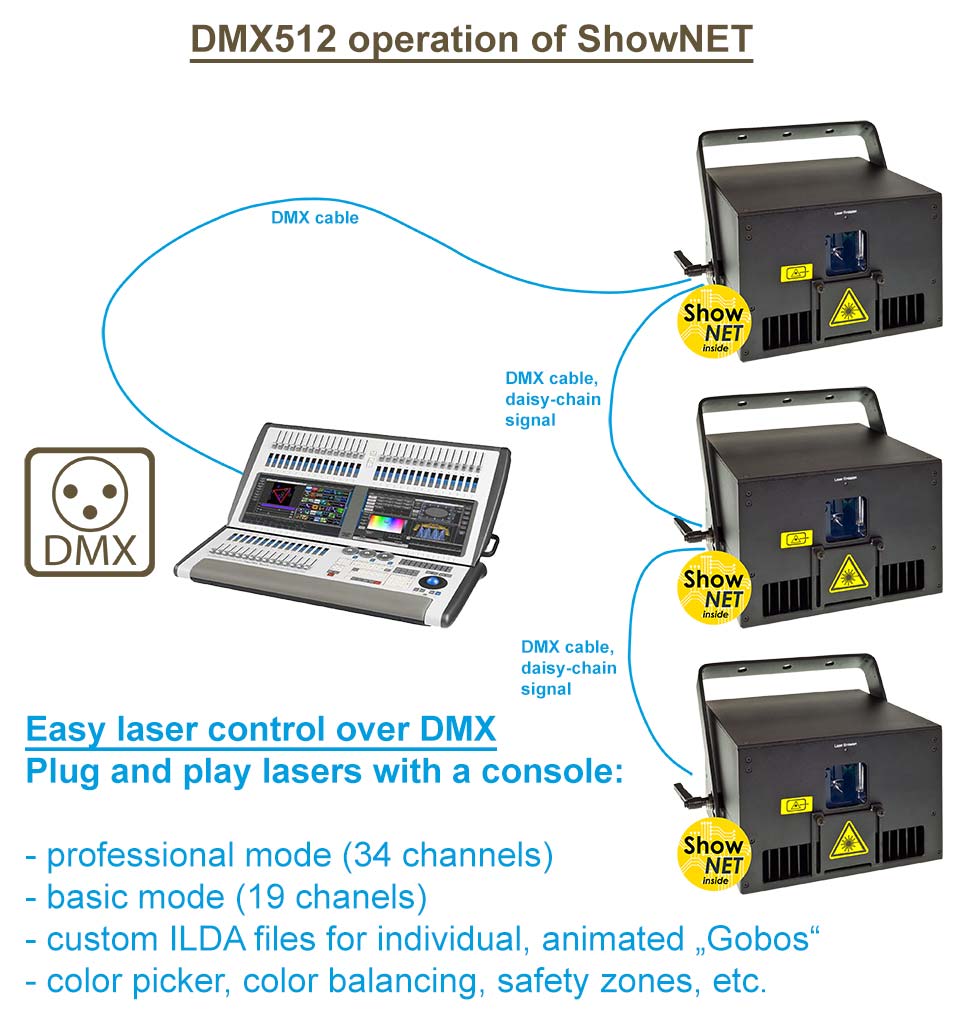
3. Use ShowNET for Stand-Alone laser operation
ShowNET comes with two different modes for stand-alone operation:
The Automatic-/Stand-alone mode just plays the ILDA files on the SD card. It loops through the whole set of files. With activating an additional Dip switch it is possible to only have one single file play back. The files can be selected individually - see the ShowNET user manual for details.
The Demo mode not only just plays the files on the SD card and loops through the whole set, it also applies automatic effects to these files. This makes the whole display more vivid. It is especially designed for the use by mobile DJs, entertainers or in smaller nightclubs.
The stand-alone operation in automatic mode is especially suitable for logo projections, advertisement, architecture projectione, etc., where unattended, automated laser display is required.
4. Use ShowNET for Sound-to-Light / music triggered laser operation
ShowNET can also run in Sound-to-Light mode. This, however, only applies to integrated ShowNET boards that have the additional Sound-to-Light board attached. External ShowNET devices and those without the Sound-to-Light board do not have this feature.
In Sound-to-Light mode ShowNET plays back the ILDA files on the SD card based on the beat of the music. It also applies animation effects to these frames, to make them look more dynamic. The devices with Sound-to-Light board have a trim pot for adjusting the microphone sensitivity.
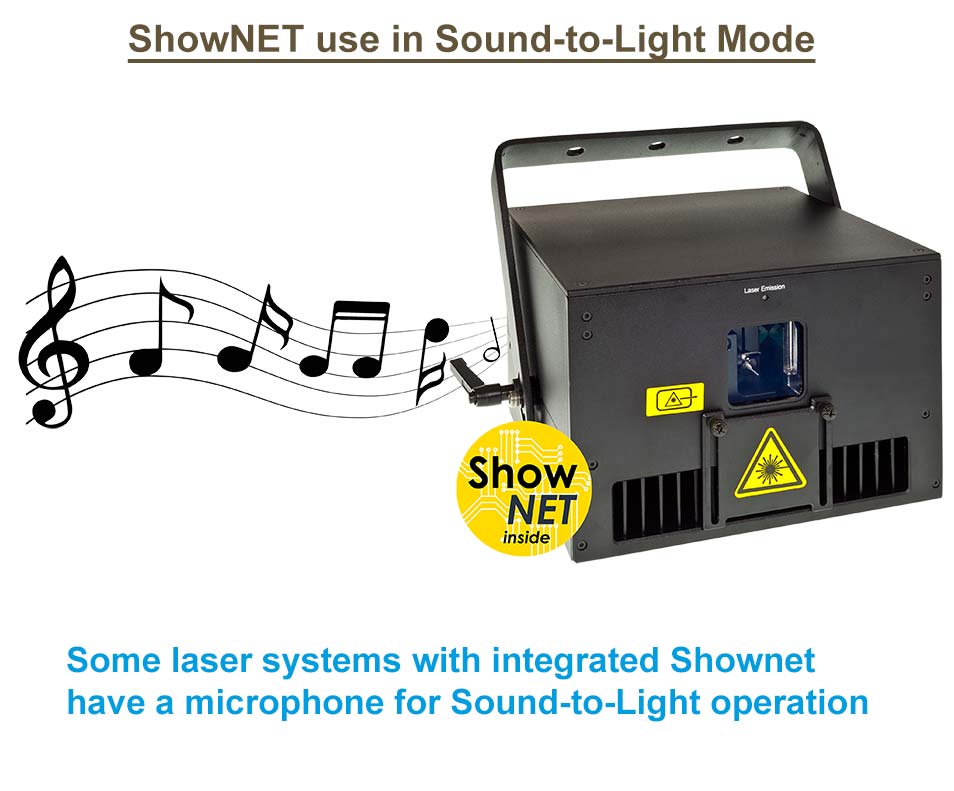
5. Use ShowNET as DAC / laser interface for direct software laser control via Showcontroller
ShowNET can act as direct output DAC for the professional laser show control software SHOWCONTROLLER as well: Simply connect the lasers and the computer with a standard Network / Ethernet infrastructure and use Showcontroller with the ShowNET as DAC. Showcontroller license dongles can be obtained from your preferred AVL retailer.
Find more details on the Showcontroller software and how easy it is to use on the website https://www.showcontroller.com
You can download the Demo Version of the Showcontroller software here: https://www.showcontroller.com/en/downloads/showcontroller-software
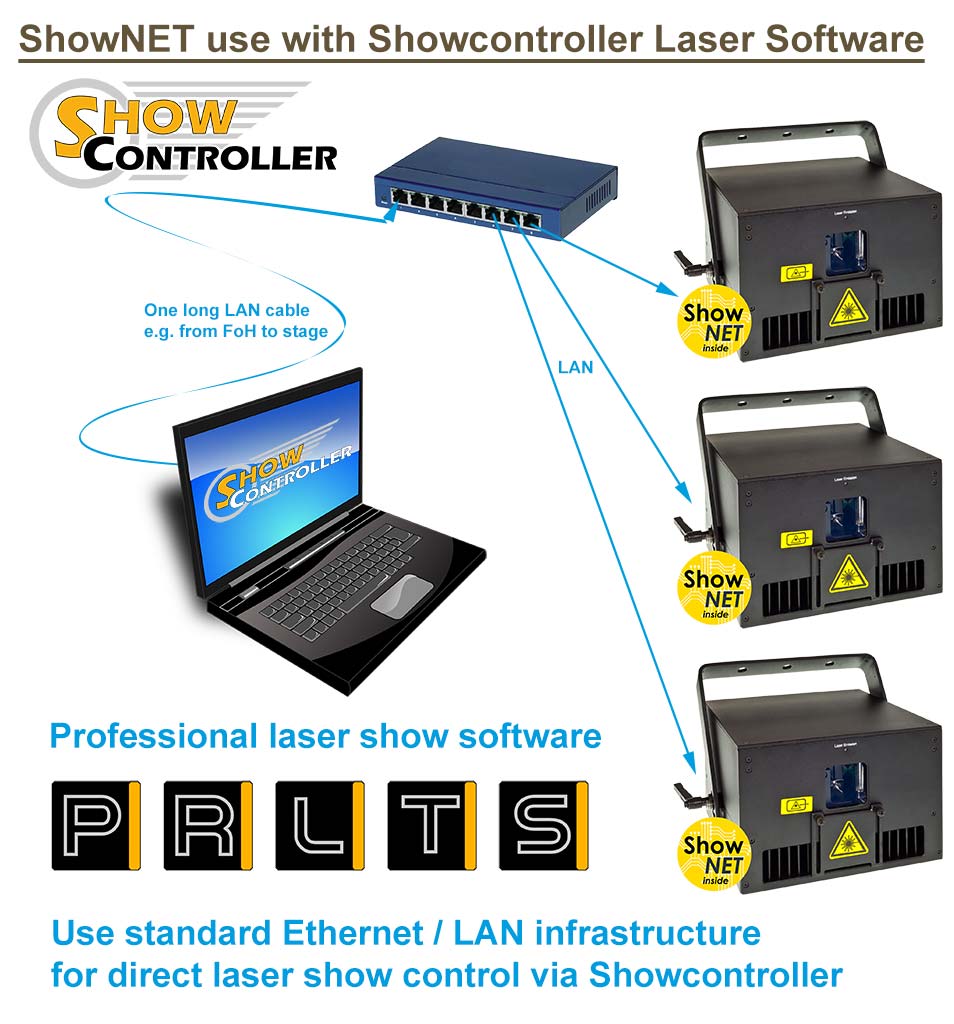
6. Use ShowNET as DAC / laser interface for direct software laser control via Showeditor
ShowNET interfaces come with a full software license for Showeditor. To use the Showeditor software with any ShowNET device (internal or external), download the software from https://www.showeditor.com and follow the instructions.
Showeditor is a versatile laser control software, that already comes woith 250 free laser shows. It has a timeline-programming part as well as a live laser show user interface.
You can use Showeditor to create custom ILDA files for the use with the SD card of the ShowNET.
Easily create own logos, texts, graphics or animations with Showeditor and save them as ILDA (*.ild) file in the appropriate ILDA standard 5 file format.
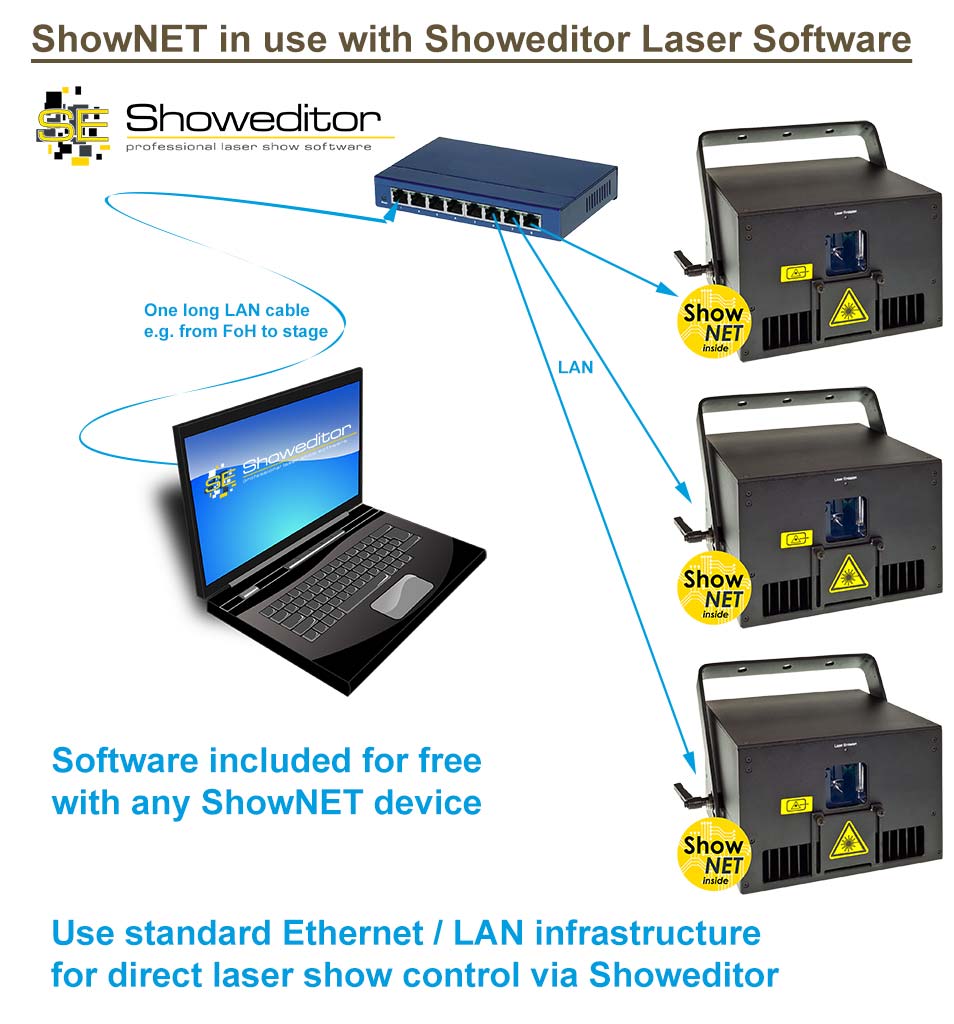
Showeditor uses a normal Ethernet / LAN infrastructure, so it can easily be used with any ShowNET device. Learn more about the features of Showeditor here: https://www.showeditor.com/en
7. Use ShowNET for ILDA Streaming
ILDA Streaming is the real-time signal transmission of an ILDA signal via a combination of sender and receiver over network (LAN).
It is possible to use the ShowNET interfaces as senders or receivers for ILDA Streaming. Whereas the external ShowNET devices can act both as sender and receiver, the internal ShowNET boards focus on the receiver functionality.
This is how ILDA Streaming works:
The ILDA signal comes from a random DAC (e.g. FB3, Phoenix USB, etc.) and is feeded with a short ILDA cable to the sender. The sender transforms the signal to a digital network protocol and streams it to the network. The receiver gets the signal that was specified for it and transforms it back to the analog ILDA signal.
The advantage is, that the possible transmission distances of network signals is very long and network cables are easily available all over the world. ILDA cables are rather limited in their maximum possible length, so the physical limits are quickly reached at large scale productions. ILDA streaming is a good and stable option to easily extend the signal transmission distances. This method has been explicitly developed for show laser light applications, so it is superior to USB->LAN converters if it comes to laser applications.
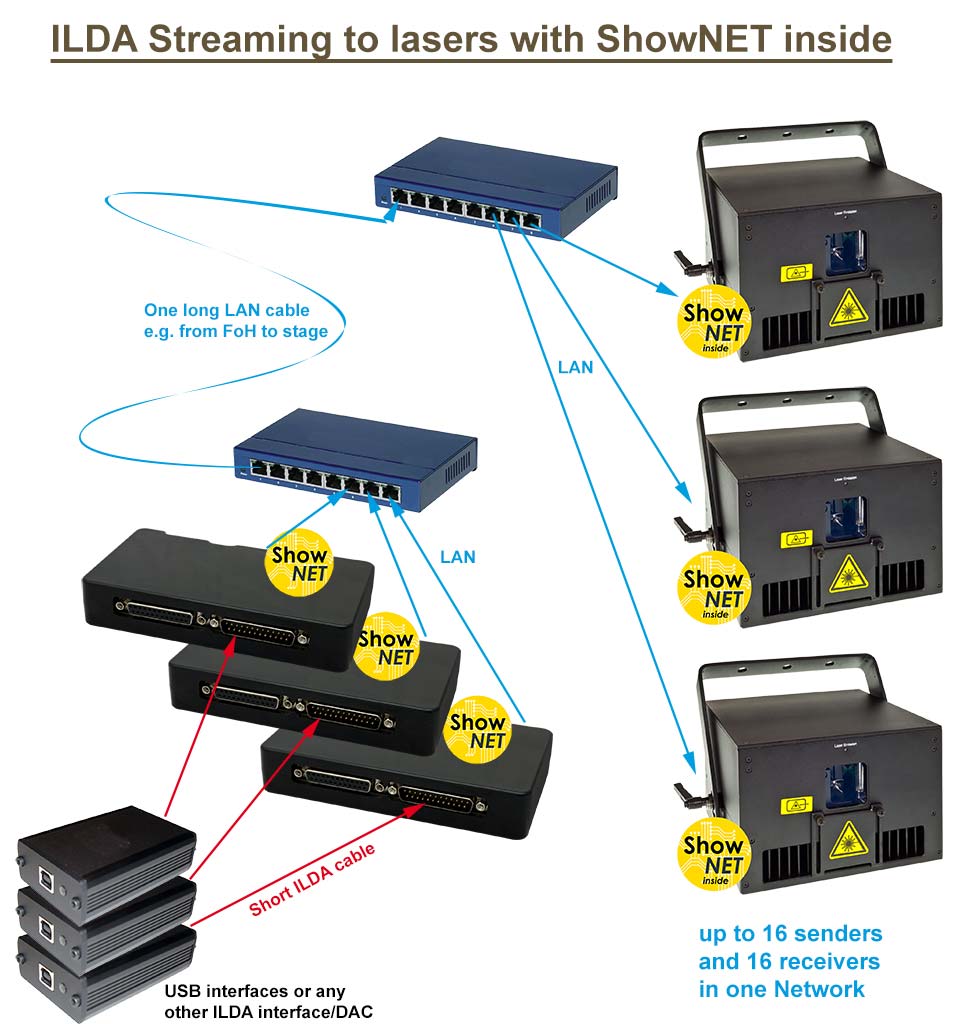
ILDA Streaming with systems with more than 3 color channels:
If an ILDA signal with more than three color channels is to be transmitted (which is only the case with top professional laser systems, usually with OPSL sources), both sender and receiver need to be capable of handling a six color channel signal.
8. Use ShowNET for Master-Slave laser operation
ShowNET - external and internal - can be used for controlling laser systems in master-slave operation. This means, that one ShowNET acts as "master" and the others as "slaves" They are linked with standard DMX cables.
The master ShowNETsends the control signal and thus triggers the slave ShowNET to do the same. All ShowNETs in a master-slave chain should have the same ILDA files on their SD cards, otherwise the result would be different.
The master-slave operation principle is, that the master ShowNET sends out DMX control signals and the slave ShowNETs act according to these signals. These signals are just trigger signals, so no intelligence is transmitted - this already resides in the slave ShowNETs.
Master-slave operation is possible in Sound-to-Light mode or Demo-Mode (see ShowNET manual). Only the master ShowNET is relevant, the Slaves just act to the trigger of the master.
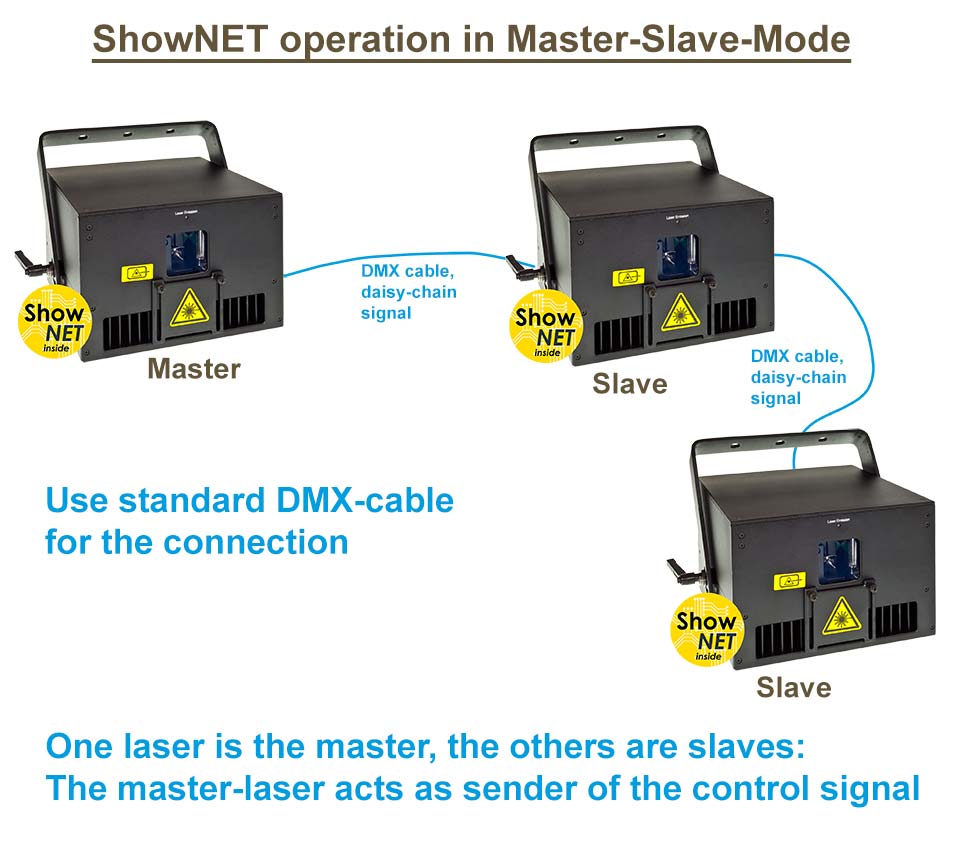

Distributed brands: